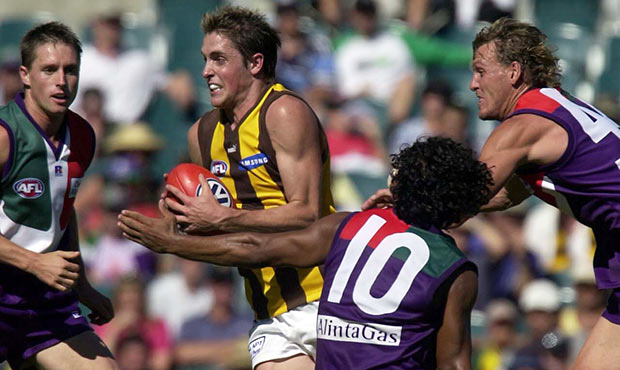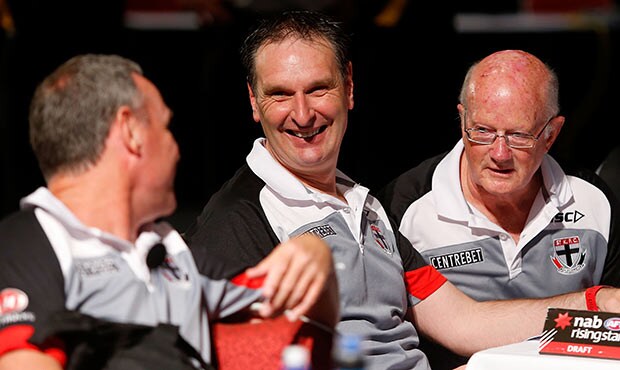In the second of his articles for AFL.com.au in the lead-up to the NAB AFL national and rookie drafts, long-time AFL list manager Chris Pelchen plays the role of myth-buster as he examines many of the long-standing theories about picking players.
AS WE approach next week's national draft on the Gold Coast, speculation will mount around some of the supposed "myths" associated with the draft process and how clubs might consider making their important recruiting decisions.
LIVE CHAT: Join Chris Pelchen as he takes over the @AFL Twitter account for a live question and answer session at 4pm AEDT on Thursday, 19 November.
What follows are ten questions and statements about the draft and whether they are actually fact or fiction.
1. "We will pick the best available player."
Fiction – There is some truth to this statement, particularly in the early selections of the draft, but it is more a common term of phrase used by clubs in the media than anything of substance. Obviously recruiters are reluctant to divulge their intentions prior to the draft so it is more convenient to use the above statement rather than identify positional needs and risk exposing proposed strategies. But clubs are very conscious of team structures as the draft progresses and when the talent base becomes less clearly definable, greater attention is applied to positional requirements as the priority.
2. "There's no such thing as a draft smokey anymore."
Fact – While players may sometimes slip under the radar of various clubs, the extensive recruiting networks operating in 2014 make it extremely unlikely that any player is known to only one team. Obviously, a player's ranking will vary from club-to-club in each year but the need for players to nominate for the draft, combined with full-time AFL staff managing the talent pathway throughout Australia, means that the likelihood of a "smokey" in the draft has all but disappeared. You just can't hide talented players any more!
Two of the best smokies from years gone by were:
Luke McPharlin (Hawthorn) – Pick 10, 1999 National Draft
Recruited from East Fremantle after only a couple of games in their Colts (juniors). Hawks recruiting manager, John Turnbull using his close contacts in Western Australia to make a bold but highly successful call on a largely unknown player – particularly brave when considering he was using their first round selection.
Hawthorn took a draft gamble with Luke McPharlin who was traded to Fremantle in 2001. Picture: AFL Media
James Gwilt (St Kilda) – Pick 63, 2004 National Draft
Recruited from Noble Park in south-east Melbourne as a highly speculative pick by legendary Saints recruiter, John Beveridge. The story goes that “The Professor” (as Allan Jeans called him) was so worried that other clubs might know about the virtually unknown Gwilt that he didn’t sleep the night before the 2004 draft.
3. "We only made up our mind the night before the draft."
Fiction – This is very unlikely to be true because clubs will invest many, many hours into their decisions on prospective recruits. While everyone is entitled to change their minds from time-to-time, it would be extremely rare for a team to arrive at their decision on a player the night before the draft. The exception to this rule would be if a critical piece of information became available to a club at late notice such as an injury or an off-field issue.
4. "The combine results have a big bearing on where a player is selected in the draft."
Fiction – While the combine does play an important part in a club's thinking on a player, it is purely complementary to the assessments of ability and character formed over a much longer period. The combine could be compared to a school exam, which brings a "full stop" on a student’s year, but is of lesser importance than the weekly assignments, tests and homework that contribute to their overall result.
5. "If he can't kick, he can't play!"
Fact – While this is simply a figure of speech, AFL clubs are placing a greater focus on a player's ability to kick the ball. Disposal skills - both by hand and foot - have become a priority at AFL level because of the need to retain possession and minimise the impact of turnovers to the opposition. While many factors contribute to the profile of the modern player - including character, competitiveness, resilience and discipline - good kicking remains a critical quality that clubs seek in their prospective recruits.
6. "Clubs prefer to draft players from their home state."
Fiction – This may have been the case in earlier years but the maturity of the draft system combined with better education by the AFL and AFLPA has meant that both the clubs and the players are increasingly aware and accepting that professional football can take them to almost any state in Australia. Player development and welfare programs are also more consistent throughout the AFL competition - so there is a lesser need or desire from players and their families to stay in their home states.
7. "We couldn't believe he was still available at our pick!"
Fact – While the media and fans can scoff at clubs for making this remark following the draft, it is true that recruiting staff are often surprised that certain players are available at their selections. This can be explained by the simple fact that all clubs rank players differently so it stands to reason that they will be selected in varying orders by each team. When you inevitably hear someone make this comment after the 2014 draft, it is likely to be sincerely meant - not merely a throwaway line to create false hope among supporters.
All smiles on draft night: Chris Pelchen gets set for a big call for the Saints. Picture: AFL Media
8. "Key position players are a priority over other types of players."
Fiction – While talented key position players are highly regarded by clubs, they are not prioritised over other players - unless for genuine need. Clubs will target the player considered to provide them with the best return on investment and should this be a key position player, then under normal circumstances, it is simply considered a bonus. A player's ability will not be justified by his height but rather by his performance - despite clubs sometimes appearing to be enticed by key position players, it is rarely exclusive of others.
9. "The senior coach makes the final decision on who is selected at the draft."
Fiction – Whereas the senior coach often had the final call on players selected in earlier drafts, this situation has changed over the last five to 10 years. While decision making can vary from team-to-team, AFL clubs are now more modern functioning organisations and similar to their US counterparts, have full-time staff who specialise in list management and player recruitment. These personnel are responsible for watching draft prospects on a weekly basis and are entrusted with making professional recruiting decisions - obviously, not in isolation to the senior coach but most importantly, in the best interests of the whole club.
10. "The rookie draft is more important than it was in the past."
Fact – Historically, the national draft was considered of far greater importance than the rookie draft but that has changed in recent years. Clubs now view the rookie draft as an extension of the national draft and prepare for it with genuine commitment and intent. The success of rookie-listed players, combined with the limited opportunity for clubs to change their lists outside the draft period has ensured that similar resources are applied to both the recruitment and development of rookies as to that of any other player.
* * * * * * * * * *
Every draft raises further questions and creates even more conjecture around the process that is the lifeblood of AFL clubs in the 21st century.
While player lists are not built exclusively through the draft, they do present teams with the first opportunity to secure new talent into the system - an opportunity that involves careful planning, research and strategy to derive maximum benefit to each club.
Draft success normally equates to on-field success, and that's a fact...not fiction!




